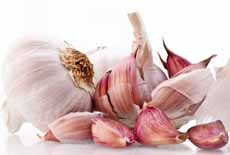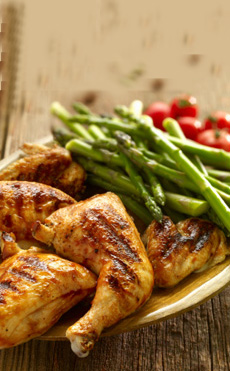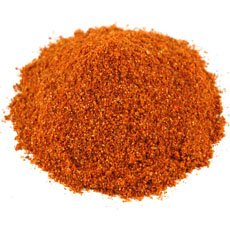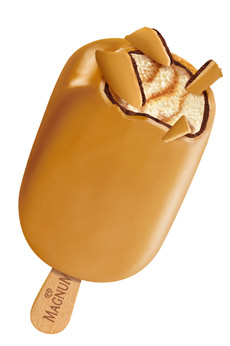
[1] Store-bought or homemade, aïoli, garlic mayonnaise, is a treat (photo © Viktor | Fotolia).

[2] Pink garlic, originally from France and now grown elsewhere, is sweeter and milder than white garlic, and also keeps much longer (photo © South African Garlic Growers Association).
|
|
Last week we published easy asparagus recipes, suggesting an aïoli dip (more formally, sauce aïoli, which is garlic mayonnaise).
Then we realized that we’d never published an aïoli recipe. Here, we remedy the situation.
First, the word is pronounced eye-OH-lee from the French word for garlic, ail (pronounced EYE).
Second, you can buy prepared aïoli, although it may be hard to find outside of specialty food markets. Our favorite brand is the Restaurant Lulu Aïoli, a NIBBLE Top Pick Of The Week (our review).
This recipe uses the classic technique of mortar and pestle. If you want to cut corners, you can use a blender (see footnote*).
However, Julia Child advised against it. The metal blades create bitterness in the garlic, she notes, and the consistency isn’t as heavy and correct.
RECIPE FOR AÏOLI (GARLIC MAYONNAISE)
Ingredients For 2 Cups Of Sauce
1 (1/2-inch thick) slice white bread, crust removed (stale bread can be used)
3 tablespoons Champagne vinegar or white wine vinegar
4-8 large garlic cloves, peeled and mashed
1 egg yolk, room temperature†
1/4 teaspoon kosher salt or sea salt
1-1/2 cups good olive oil
3 tablespoons freshly squeezed lemon juice
1/2 teaspoon grated lemon zest
Optional: 1/2 teaspoon saffron threads
Freshly ground black pepper
|
Preparation
1. BREAK the bread into pieces. Place in a mortar or small, heavy bowl and cover with vinegar; set aside for 5-10 minutes until bread is soft and pulpy. Twist the bread into a ball to extract liquid (you can squeeze it in a cloth or paper towel).
2. PLACE bread and garlic cloves into mortar and pound with a pestle for 5 minutes or longer, until you have a very smooth paste. Alternative blender instructions are in the footnote* below.
3. ADD the egg yolk and salt, and pound until the mixture is thick and sticky.
4. ADD the olive oil drop by drop, pounding and blending. When the sauce has thickened to the consistency of sour cream, you can trade the pestle for a wire whisk and add the oil more quickly. You have the right consistency when the sauce should be like thick sour cream and holds its shape with a spoon. Adjust seasoning with salt and pepper. (If the sauce is too thick for your taste, thin it with boiling water or fish stock.)
TIP: Should the sauce curdle, here’s the remedy: Warm a bowl in the microwave. Add 1 teaspoon of Dijon or other prepared mustard and 1 tablespoon of the aïoli. Whisk until blended and thickened. Add the remaining aïoli a couple of teaspoons at a time, blending thoroughly before adding more.
__________________________________
*Place all the ingredients except olive oil into the bowl of a food processor and purée into a paste. Then, with the processor running, slowly pour the oil through the feed tube and process until the sauce is the consistency of thick sour cream.
†For recipes that call for eggs that are raw or undercooked when the dish is served, use shell eggs that have been treated to destroy salmonella by pasteurization (or another approved method).
|
|
Aïoli can be varied with different flavors, from basil (pesto aïoli) and cilantro to red pepper, spicy, tomato and truffle. As an egg and oil-based sauce, aïoli can take on just about any flavor.
Check out our favorite flavored mayonnaise, from bacon and chipotle to wasabi, and look for the wonderfully flavored mayos from The Ojai Cook.
WAYS TO SERVE AÏOLI SAUCE
Aïoli can be used instead of mayonnaise anywhere, from canapés to sandwiches and potato salad. Here are the classic French uses:
With escargots
With fish and seafood: boiled fish (in France, cod and aïoli are a popular pair), bourride (Provençal fish soup), and in America, with broiled fish and seafood, crab cakes and shrimp cocktail
Spread on hard-cooked eggs
On vegetables, especially boiled potatoes and string beans
As a substitute for butter, oil, or vinaigrette
For a delightful side, make:
RECIPE: FINGERLING POTATOES WITH AÏOLI
Ingredients
2 1/2 pounds fingerling potatoes, unpeeled, cleaned, and patted dry
Kosher salt
Fresh chives for garnish, minced
Ground pepper to taste
|
|

[3] For a Provençal twist on artichokes, steam them and dip them in aïoli instead of melted butter or vinaigrette (photo © Annie Glass).
|
Preparation
1. PLACE the potatoes in a large saucepan with 1 tablespoon of salt. Cover with cold water and bring to a boil.
2. SIMMER uncovered for 15 to 20 minutes, until just tender. Drain in a colander and place a kitchen towel on top, allowing the potatoes to steam for 5 to 10 minutes.
3. SLICE the potatoes in half and place them on a serving plate. Sprinkle with salt, pepper, and chives. Serve the aïoli in a ramekin for spreading or dipping.
FIND MORE OF OUR FAVORITE VEGETABLE RECIPES.
Use the pull-down menu in the right column.
CHECK OUT WHAT’S HAPPENING ON OUR HOME PAGE, THENIBBLE.COM.
|
|








